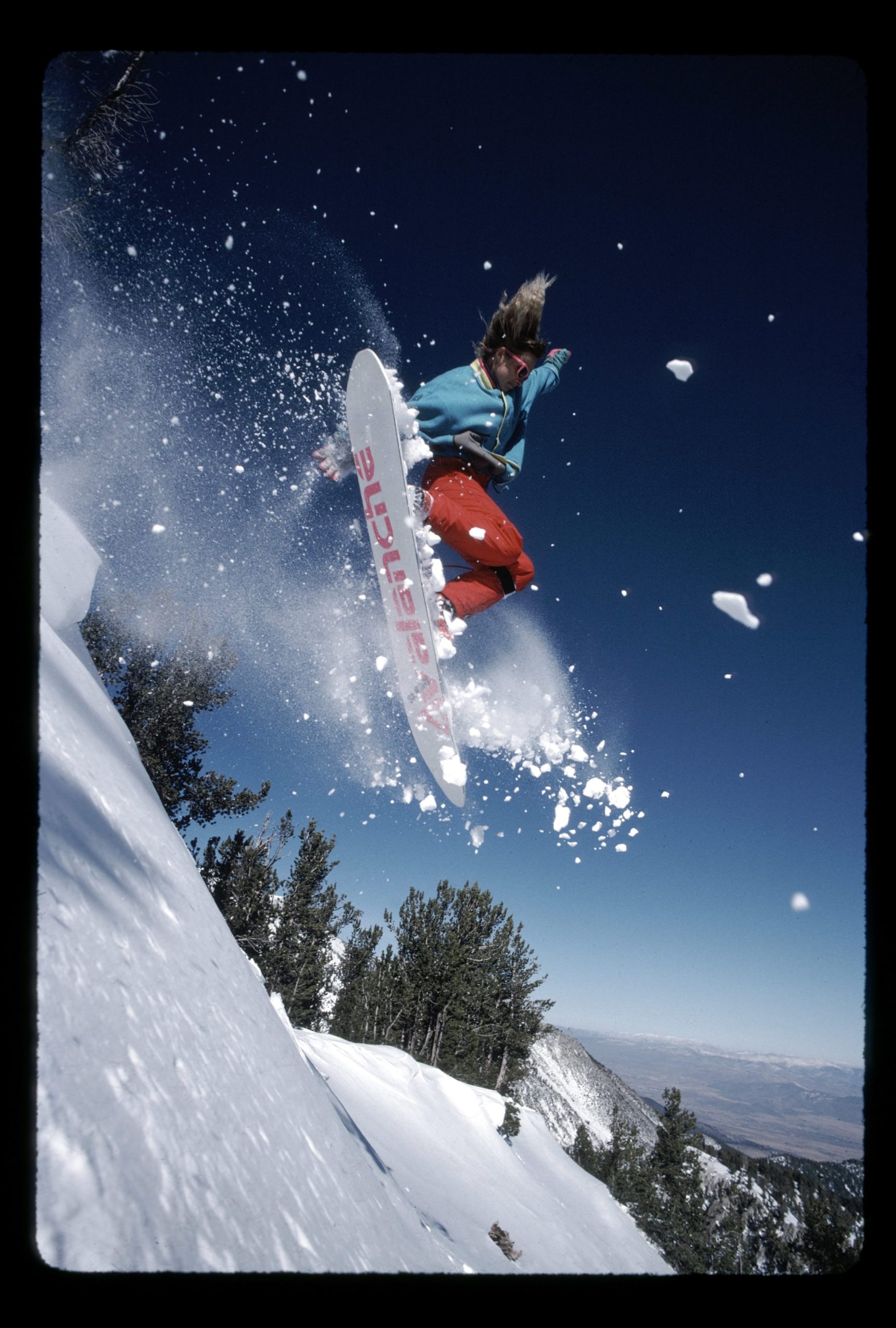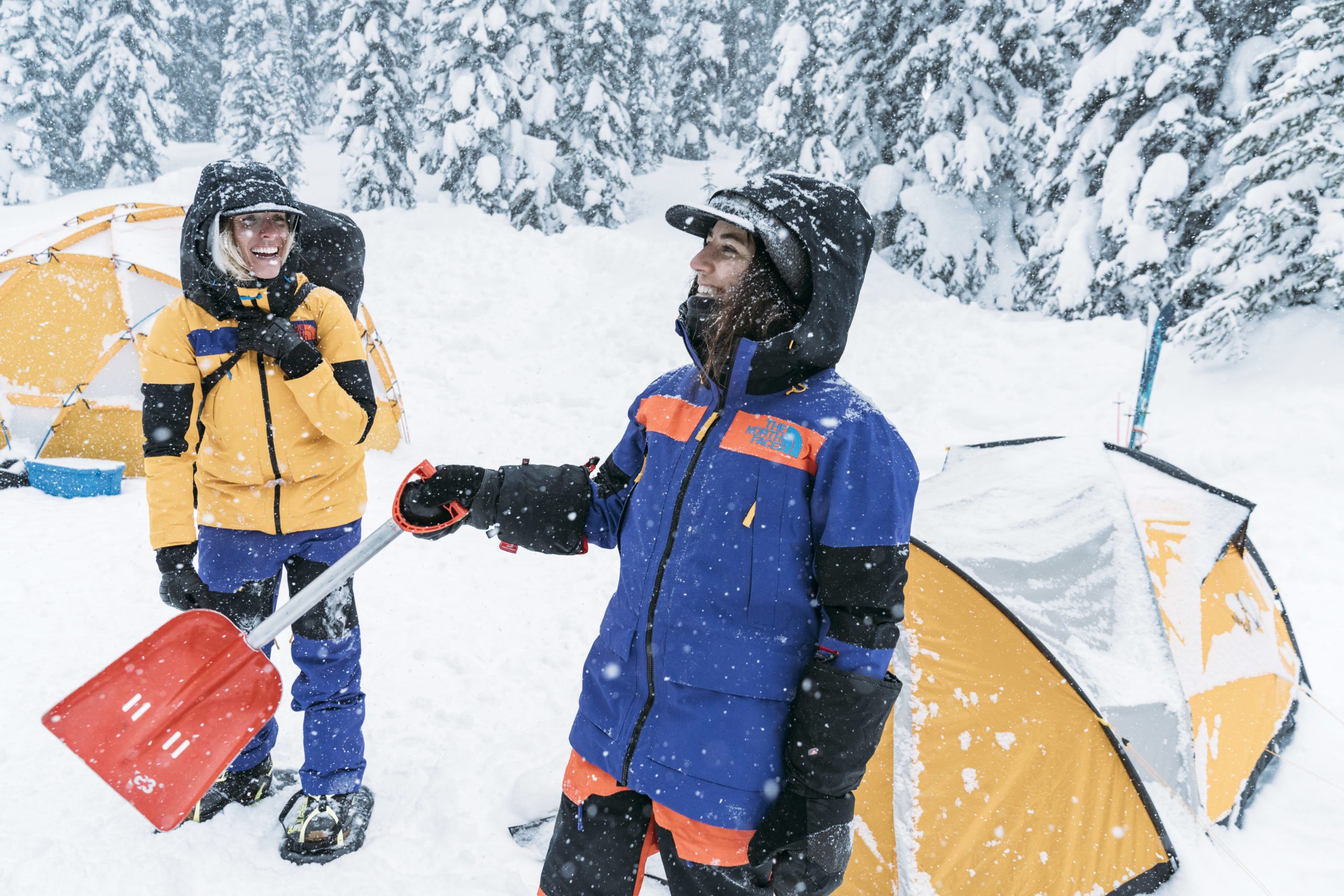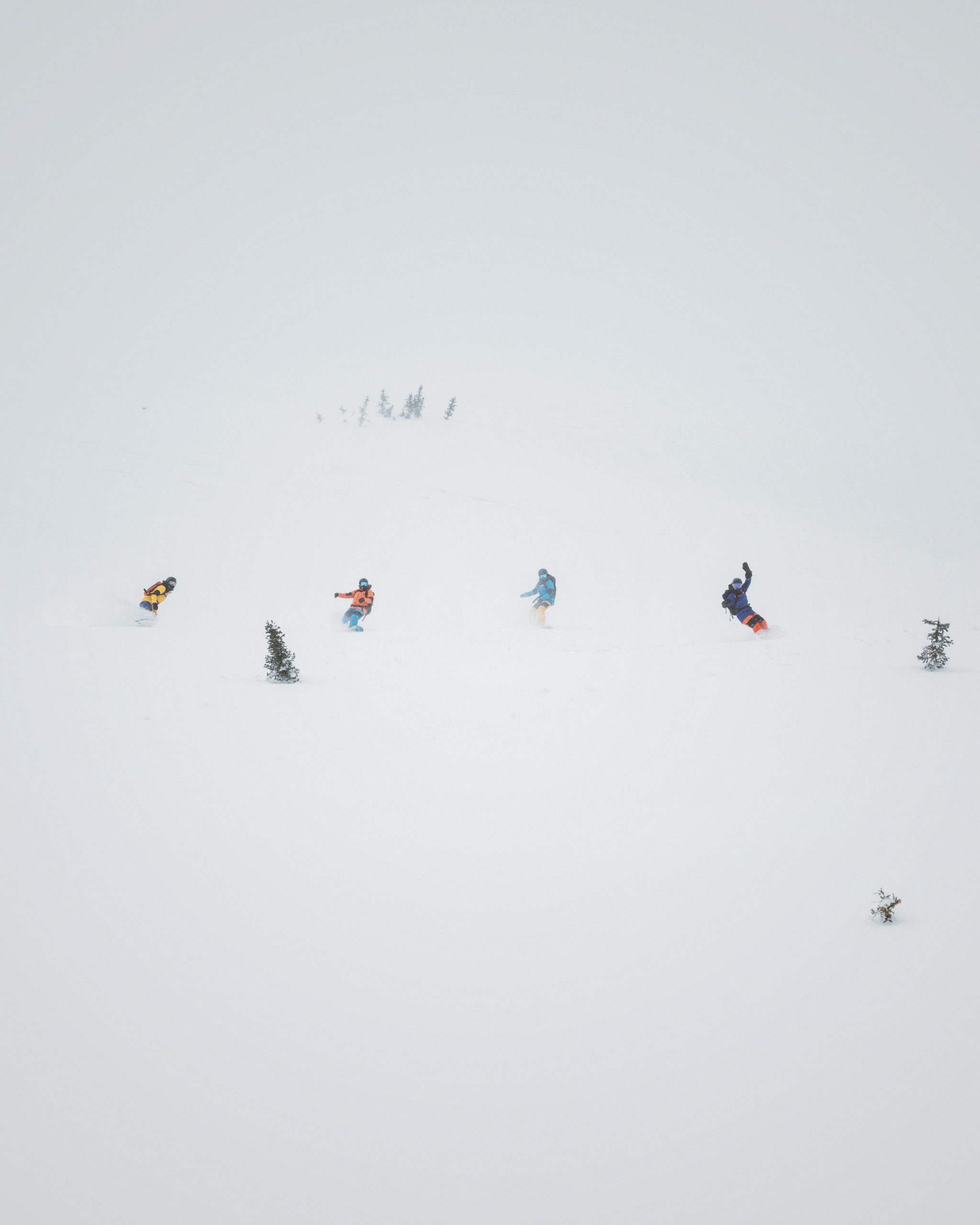This article was produced in partnership with The North Face.
It was in 1988 when The North Face signed their first female snowboard athlete, Bonnie Zellers, a pioneer—though she’s too modest to tell you that—whose love of the mountains, first as a climber and then as a rider, took her deep into the backcountry of the Sierra, AK, Europe, Nepal, and countless other ranges. While at the time, Bonnie and her cohorts were living in the moment when breaking trail, they were also setting the stage for the individuals who would step out into the mountains in the decades to follow. Two years ago, building on the legacy catalyzed by Bonnie, The North Face assembled a heavy hitting group of five female riders to add to their snowboard team: Leanne Pelosi, Jess Kimura, Amanda Hankison, Marion Haerty, and Mary Rand. This crew, whose backgrounds are all unique, rife with rails, contests, and more, has set a pace in the backcountry. Last winter, they met up all together in the mountains for the first time (minus Marion) to film for TNF’s new short film, Facets.
Facets is an exploration of these individuals who form the whole. These riders that come together to explore the mountains and the way that their perspectives, experiences, and aspirations coalesce. While the trip to film for Facets in Retallack, British Columbia, was cut short, the experience for Jess, Leanne, Amanda, and Mary was significant. Recently, this crew linked up with Bonnie to discuss where snowboarding has been, where it is, and where it’s going, to share stories about winter camping in Retallack, and to look ahead at this coming winter and offer advice about getting into the backcountry. Below, enjoy excerpts from the roundtable discussion. You can watch the full conversation presented by The North Face and SNOWBOARDER, here, and be sure to check out Facets below, while you’re at it. – Mary T. Walsh
ON THE TEAM RIDING ALL TOGETHER FOR THE FIRST TIME
Leanne Pelosi: I think it was pretty seamless. Being at a cat operation, we started off catboarding and realized quickly that we should get on our snowmobiles and cruise around and find features and zones. Basically, our day would start out the previous evening, just making a plan [for the next day]. I think that with the conditions that we had, we made pretty good calls on what to ride. We had this crazy cold snap and then it got crazy warm and the avalanche conditions were not good. So, the big mountain stuff was out of the picture, and then the sun kind of baked the snow down low. So, we were dealing with tricky conditions, plus COVID and a short period of time to get it all done. It was hard, but it was really fun that we were able to come together and ride.
Jess Kimura: I could really tell that Leanne has been filming for the longest. It was sick to see, she just got it. She would make me feel better about taking a long time to set up a shot and pull out her drone and help from a filmmaking perspective and just from a “Hey do you actually think I can do this?” perspective. That was pretty cool to see in real life because I don’t think we’ve really ever filmed—we’ve gone out and shot photos a couple of times, but we’ve never really straight-up filmed together.
Amanda Hankison: It was so sick. I don’t think there’s ever been a time that all four of us—maybe Rider’s Poll might have been the only time all four of us have even been in the same room, but we all spend time in the same places. Everyone was so competent and then we all just came together and everyone took care of their own shit. You’d look over and you’re stoked on what they’re working on and they’re looking at you and they’re stoked on what you’re doing—you’re picking stuff out for each other. I was so excited about the potential and then it got cut short.
Jess Kimura: We were camping with no service. It wasn’t like we were fake camping, ha, we were actually camping. It was minus 30 and we had no cell service. We were at Retallak, but we weren’t cat skiing. We got dumped off in a field far away to put together these giant dome tents. Every couple of days we would come back to the lodge for whatever we had to do. I remember the first time we came back, they were like, “Oh, things are getting weird out there.” And we were like, “What are you guys talking about?” And then we’d go back to our campsite and we’d come back a few days later and the guy would be like, “The world as we know it has changed!” and we were like, “What the fuck is going on?!” We didn’t have the news, we didn’t have the internet, we didn’t have anything—we couldn’t believe it. It was like, boom, pandemic.
ON THE HIGHS AND LOWS WINTER CAMPING:
Leanne: [A high was] being cozy in the inferno sleeping bag, I would have to say. I also had a warm water bottle that I put down by my feet and I had never really spent that much time in cold, cold weather, so feeling cozy was pretty sweet. But then I got so parched in the middle of the night and it was too cold to get out of my tent, so I decided that I should maybe drink the water that was in the water bottle by my feet. It said “do not drink” but I just drank it anyway and I thought I was gonna die. I was by myself so I was like, “Oh my god, am I gonna die?”
Jess: Wait, speaking of dying in your tent. We got oxygen deprivation! Don’t you guys remember? Because we didn’t know—the winter tents, they’re not like mesh like summer tents, so we had all the windows and everything zipped up. It was not Amanda’s first time [winter camping], probably, but it was my first time winter camping for real and I kept waking up in the middle of the night feeling like I was having a panic attack, being like “I can’t breathe! I can’t breathe!” And then the next morning I was like, “I’m such a dork,” but then we hear from Leslie [the photographer] and Mary that they also freaked out in the night because they couldn’t breathe too—because you just use up all the oxygen in the tent. It was crazy. Keep your vents open, guys.
Amanda: We were just in the Dutch oven you know? Gotta keep it in.
Jess: Oh yeah! I was in Amanda’s tent, poor Amanda. We were eating cheesies and farting in there.
Amanda: Bonnie, I’m sure you’re familiar with the smell.
Bonnie: Oh yeah, ha.
Amanda: I feel like that doesn’t get talked about enough, what winter camping truly smells like.
Bonnie: I know. After a few days, it’s like oh boy. I have [gone winter camping] enough to know that I’m good with summer camping these days, ha. Your boots are frozen in the morning and it’s like, Okay, we gotta get up and get going. It’s dark and it’s freezing and you’re trying to cram your feet into your frozen boots, but once you get going and you get out there, it’s totally worth it because you’re always in an amazing place.
ON MENTORSHIP IN SNOWBOARDING
Mary Rand: Mentorship has been an absolutely integral part of my snowboard career, what it’s become and the possibility of it early on—the people that I looked up to, the people that were my heroes then became my friends and showed me the way. It definitely happened early on in the streets with Marie-France Roy and Jess. It was huge for me then because I didn’t know what it was like to film in the streets on a real, professional level and those two definitely showed me the way. It made my career. It was a little bit different going into the backcountry and getting mentorship there because at least in the streets, rails is what I knew, but in the backcountry, the whole process was new to me. So not only was I looking for guidance on how to get out there and how to be safe and how to snowmobile and how to splitboard, but also what to ride and how to ride it. When you really have someone that takes you under their wing, that’s mentorship. Their confidence gave me the confidence to go out there and try my hardest, and know that even if I’m going to have a six-in-a-row tomahawk and I lose my goggles, they’re still going to be cheering me on and give me their goggles to try again. It’s having those people who I know so well and who I feel care about me, that really makes all the difference.
Bonnie: I did a few all-women splitboarding trips. we did one to Crater Lake in Oregon, to Wheeler Peak in Nevada, and then some of the Desolation Wilderness around here. There were like three or four of us that would go on trips together and we were kind of figuring it out together. I had some climbing experience, so that was helpful as far as the equipment, and later I had taken a level 2 avalanche course and I tried to impart that information to the women I was with. We learned together. It was an enriching experience. It gave us the strength to just go out there and be like, “We got this. We can figure this out.”
Leanne: Yeah, I think as far as mentorship, it’s integral to going out into the backcountry. Speaking to what Bonnie says, that everyone brings something to the table, it’s very true. With Full Moon, everyone had their strengths and when we came together, we lifted each other up. We were so inspired and it brought us to the next level. I remember we went to Alaska on one of the last trips. There were six of us on this peak and we were all roshambo-ing to get these lines. I won the roshambo and I was like, I better be picking the best line on this face because I’ve got five other women right here and we’re all going to cheer each other on. And there were some amazing lines that everybody did. Every single person nailed it and it was just such an inspiring moment to be a part of. I think it’s really important to surround yourself with like-minded people.
FW20 Women’s Team Kit
ON BACKCOUNTRY SAFETY HEADING IN TO THIS SEASON AND BEYOND
Leanne: I think a lot of people have a sentiment [going into this season where they’re] kind of forgetting about the ski resorts and they’re thinking they’re going to get rad in the backcountry. And I think the worry is that a lot of people without proper preparation are going to get out there and be on top of each other and things are going to happen. So, I think the important message to get out there is, have you done a C1 or an AIARE course? Do you have the knowledge to be able to rescue your partner if something happens? That kind of stuff is going to come into play. So, people, be safe.
Amanda: So, backcountry safety, there’s the beacon, shovel, probe—those are the tools that you use if someone in your party is buried. That’s how you physically find them. And you get an education and that helps you look at terrain and decide what is safe, what is not, how you’re going to go into this with everyone, how you’re going to talk about it. But there’s always the human factor, which is like the thing that exists that maybe you don’t voice, or your partner doesn’t voice, [or] it’s a misunderstanding that you had with a different party that you saw passing by you, and it’s other people’s decisions, if they’re riding above you or if they walk underneath you—you always have to be open to there being this alternative issue, even if your education is on point and your gear is on point, there’s always this other thing that you gotta watch out for—to have an awareness really, just to know that there’s something else going on.
Leanne: it’s also within your own crew. It’s knowing your own risk tolerance, and does it match up with everyone else in the crew? And if it doesn’t, then people just need to communicate that, because far too often, somebody will lead the crew thinking it’s safe and somebody else might not want to go but they go with the flow. And then something happens. Then other people in the crew are like, “Oh, I was thinking that, too.” I think communication is really important before you set out and tackle any objective. The reality is, you can’t eliminate all the hazards out there, but you can eliminate the risk. Avalanche conditions can be high, but I could go to a spot in the backcountry where I know it’s completely safe and still have fun. Taking note of the hazards and being able to choose terrain to eliminate those hazards is something that we need to do on a daily basis.
Bonnie: I think what Leanne touched on, communication, as far as speaking up when everyone else is kind of on this path and in your head, you’re like, It must be okay. Everybody else thinks it’s okay. But to be able to say, “You know what? I’m not feeling good about this,” or “I feel like we need to evaluate.” Just speaking up, it’s so important. It’s number one. Just say it.
BACKCOUNTRY RESOURCES TO CHECK OUT
– Backcountry Basic Info
– www.avalanche.ca
– Safe As Clinics
– Know Before You Go – www.KBYG.com
– Utah Avalanche Center
– Sierra Avalanche Center
– www.snowforecast.com
– Leanne and Robin Van Gyn and crew hosting an AST 1 in Whistler Jan 2-3, 2021 – Stay tuned to @leannepelosi on Instagram for info
Original Post from this site


